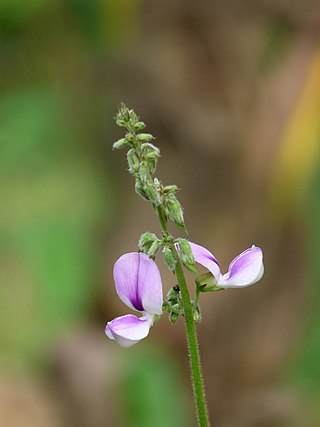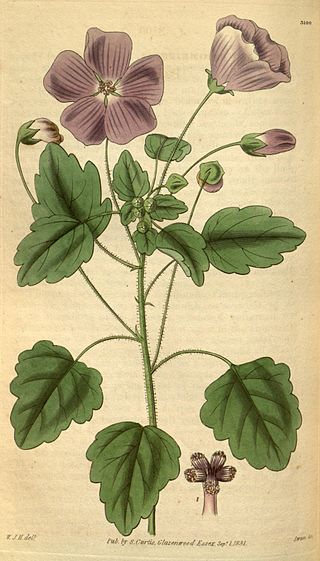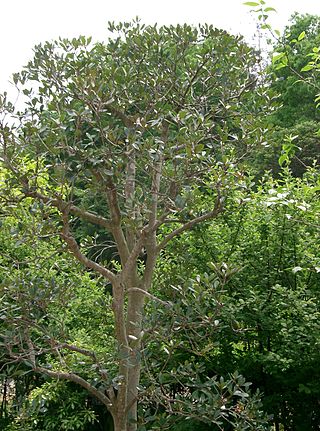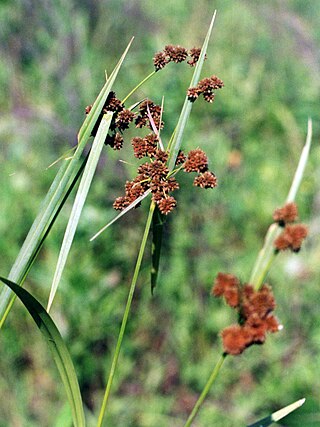
Mimosa is a genus of about 590 species of herbs and shrubs, in the mimosoid clade of the legume family Fabaceae. The generic name is derived from the Greek word μῖμος (mimos), an "actor" or "mime", and the feminine suffix -osa, "resembling", suggesting its 'sensitive leaves' which seem to 'mimic conscious life'.

Lygodium is a genus of about 40 species of ferns, native to tropical regions across the world, with a few temperate species in eastern Asia and eastern North America. It is the sole genus in the family Lygodiaceae in the Pteridophyte Phylogeny Group classification of 2016. Alternatively, the genus may be placed as the only genus in the subfamily Lygodioideae of a more broadly defined family Schizaeaceae, the family placement used in Plants of the World Online as of November 2019.

Myrciaria floribunda, commonly known as cambuizeiro, guavaberry or rumberry, is a species of plant in the family Myrtaceae. It can be found across South and Central America and the West Indies in dry or moist coastal woodlands, up to 300 metres above sea level. The guavaberry, which should not be confused with the guava, is a close relative of camu camu.

Pueraria is a genus of 15–20 species of legumes native to Asia. The best known member is kudzu, also called Japanese arrowroot. The genus is named after 19th century Swiss botanist Marc Nicolas Puerari.

The Combretaceae, often called the white mangrove family, are a family of flowering plants in the order Myrtales. The family includes about 530 species of trees, shrubs, and lianas in ca 10 genera. The family includes the leadwood tree, Combretum imberbe. Three genera, Conocarpus, Laguncularia, and Lumnitzera, grow in mangrove habitats (mangals). The Combretaceae are widespread in the subtropics and tropics. Some members of this family produce useful construction timber, such as idigbo from Terminalia ivorensis. The commonly cultivated Quisqualis indica is now placed in the genus Combretum. Many plants in the Quisqualis species contain the Non-proteinogenic amino acid excitotoxin Quisqualic acid, a potent AMPA agonist.

Bombax is a genus of mainly tropical trees in the mallow family. They are native to western Africa, the Indian subcontinent, Southeast Asia, and the subtropical regions of East Asia and northern Australia. It is distinguished from the genus Ceiba, which has whiter flowers.

Calliandra is a genus of flowering plants in the pea family, Fabaceae, in the mimosoid clade of the subfamily Caesalpinioideae. It contains about 140 species that are native to tropical and subtropical regions of the Americas.

Argyranthemum is a genus of flowering plants belonging to the family Asteraceae. Members of this genus are sometimes also placed in the genus Chrysanthemum.

Palaua is a genus of malvaceous plants native to the Andes. It shares with Malope and Kitaibelia the property of possessing capitate schizocarps, and was formerly classified with them in a subfamily Malopoideae or tribe Malopeae. It is now considered to be more closely related to Sphaeralcea, and to other Andean mallows.

Pál Kitaibel was a Hungarian botanist and chemist.

The Pentaphylacaceae are a small family of plants within the order Ericales. In the APG III system of 2009, it includes the former family Ternstroemiaceae.

Lumnitzera racemosa, commonly known as the white-flowered black mangrove, is a species of mangrove in the family Combretaceae. It is found on the eastern coast of Africa and other places in the western Indo-Pacific region. It has one accepted variety from the noniminate species, Lumnitzera racemosa var. lutea (Gaudich.) Exell.
Carex foenea is a species of flowering plant in the family Cyperaceae, native from subarctic America to the northern United States. It was first described by Carl Ludwig Willdenow in 1809.

Hylodesmum glutinosum is a species of flowering plant in the family Fabaceae. Common names include large tick-trefoil, clustered-leaved tick-trefoil, large-flowered tick-clover, pointed tick-trefoil, beggar's lice and pointed-leaved tick-trefoil. It occurs in eastern Canada, the central and eastern United States, and northeastern Mexico.

Scirpus atrovirens, known as dark-green bulrush, is a perennial sedge native to wetlands of eastern Canada and the United States. It is sometimes called dark green bulsedge, black bulrush, or green bulrush.

Theobroma speciosum is an arboriform species of flowering plant in the mallow family native to northern South America. It is the 35th most abundant species of tree in the Amazon rainforest.
Pancovia is a genus of flowering plants belonging to the family Sapindaceae.
Zanthoxyloideae is a subfamily of the family Rutaceae.

Carex digitalis is a tussock-forming species of perennial sedge in the family Cyperaceae. It is native to south eastern parts of Canada as well as central and eastern parts of the United States.

Carex vestita, also commonly known as velvet sedge, is a tussock-forming species of perennial sedge in the family Cyperaceae. It is native to eastern parts of the United States.

















